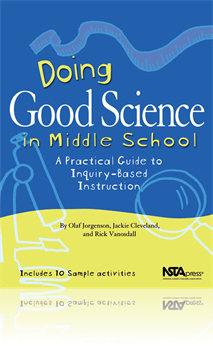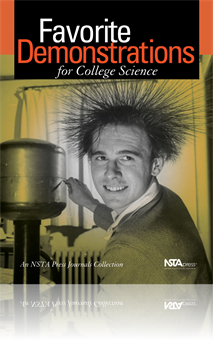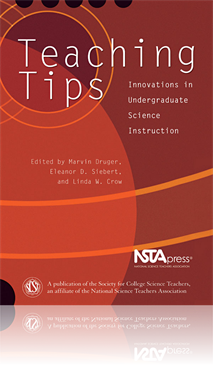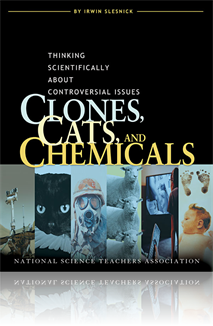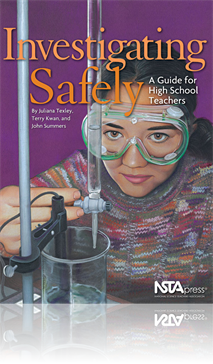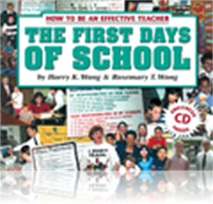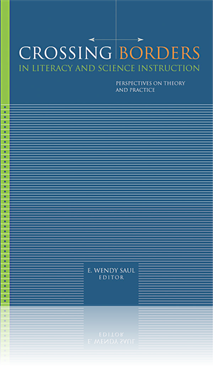All Resources
Journal Article
After the Bell: Breaking the Code: Examining Your Mail
Given the amount of mail that arrives during the holidays--from early December to early January--the post holiday season provides an excellent opportunity to perform an informal science and mathematics classification activity--determining where our m...
Journal Article
Seeking to revitalize a unit on rocks, sand, and soil for first-graders, the authors created new hands-on lessons. These included testing the hardness of rocks, making models of the Earth, and sorting rocks. As a culminating activity, students partic...
Journal Article
In this month's section we explore the integration of math into the science curriculum. Meaningful math and science integration can also help teachers identify specific skills and standards that support their science and mathematics curricula. ...
Journal Article
Home Connections: Counting Populations
This activity, designed for students to do at home, introduces the concept of population sampling. Students scatter pasta on a grid and count the number of pieces in three sample boxes....
Journal Article
The Idea Bank provides tips and techniques for creative teaching, in about 1,000 words. In this month’s Idea Bank, the science faculty is looking for ways to engage all students in a course that allows them to achieve their greatest individual pote...
Journal Article
Ask the Experts (January 2004)
Why does the Moon appear larger in winter? Why doesn't glue stick to the inside of its container?This article contains the expert's answers....
Journal Article
A new activity model for scientific inquiry is presented here with the overall intent of providing students and teachers with a deeper understanding of how science is really done. With this model students learn that the process of inquiry can follow ...
Book Chapter
Aristotle took the ideas of those who had come before him and melded them into a grand theory that attempted to explain and classify everything know. It was an enormous accomplishment, and it set a base for science that is still with us today. ...
Book Chapter
For decades, many of the nation’s life science classrooms have been anything but lively. Biology has been criticized for being content heavy, overloaded with vocabulary, and tested by rote. Six to seven hundred pages of text, presented to teenagers...
Book Chapter
Introduction to Watershed Dynamics
The title of this book, Watershed Dynamics, refers to the idea that streams, rivers, lakes, and other water bodies are dynamic systems, continuously changing in many ways—physically, chemically, and biologically. Have you ever wondered why some st...
Book Chapter
Opponents to teaching the theory of evolution declare that it is only a theory and not a fact; and that science relies on observation, replication, and experimentation, but nobody has seen the origin of the universe or the evolution of species, nor h...
Book Chapter
Classroom Management and Safety
Welcome to the challenge of making good science come to life in your classroom. In this chapter, we look at how to get the science classroom ready for inquiry-based lessons and how to prepare students for engaging, productive, and safe activities. In...
Book Chapter
A Bright Idea: Reinforcing Logico-Deductive Reasoning
Many students in freshman- and sophomore-level science courses have little experience formulating testable hypotheses. However, an accurate comprehension of the scientific method is critical for understanding experimental design and for the success ...
Book Chapter
Successful learning is more apt to occur when students are engaged in discovering and building their own frameworks of knowledge. To meet this standard, teachers must design work that actively involves students in asking questions and finding answers...
Book Chapter
This book is a compilation of brief descriptions of innovative and effective ideas, tips, and approaches in undergraduate science teaching. Assessment must be aligned with learning goals and successful learning is promoted by frequent assessment, whi...
Book Chapter
Every course covers some concepts that will present challenges to many students. Once those challenges have been identified how do you present them for successful learning? This part contains multiple articles with descriptions of effective ways that...
Book Chapter
It's only human nature to ask, "If sea anemones can clone themselves without trying, and the natural cloning powers of plants are so easily exploited, why can't we begin learning how to clone ourselves?" This chapter presents an overview of the natur...
Book Chapter
The only form of gambling under the control of the state and to which the profits accrue directly for the state, is the lotteries. In this chapter, we'll compare its profits with private gambling enterprises, and search for the true worth of this mec...
Book Chapter
Cats and Their Impact on Wildlife Populations
Could you be harboring a killer in your home? Is it possible that the cute little cat snoozing so angelically on the sofa is one of the major predators of wildlife in the United States? With a U.S. population of 60 million cats, researchers estimate ...
Book Chapter
Transplanting embryonic stem cells from embryo into adult as a means of rejuvenating diseased cells, tissues, and organs poses ethical and moral challenges. In recent years, stem cell-derived nerve and glandular tissue has been transplanted into the ...
Book Chapter
Chemical and Biological Weapons of Mass Destruction
Chemical warfare began in prehistoric times with the use of such weapons as poisoned arrows. However, World War I was the beginning of modern-day chemical warfare. The birth of biological warfare evolved during World War II. As a result, mankind has ...
Book Chapter
Robotic Versus Manned Space Travel
Manned space flights are supported by the notion that humans have an innate need to explore the universe—in specially protected spacecrafts—but at great risk to life. Congress wants manned space travel to support an industry that builds the costl...
Book Chapter
Many genetic disorders can be detected with tests of blood and chromosomes. Genetic screening is the large-scale use of these tests as part of the public health program. Different members of society, worldwide, have advocated genetic screening to ach...
Book Chapter
Many think that television and other media are primarily responsible for the aggressiveness of American youth and the youth of Western nations. Several experimental and longitudinal studies have provided considerable support to this claim. However, t...
Book Chapter
Around the world, coastlines are retreating. Economic and environmental realities offer two choices: plan a managed retreat now, or undertake a vastly more expensive program of armoring the coastline as required and retreat through a series of unpred...
Book Chapter
Modern hunting is embroiled in a major controversy. There are approximately 14 million hunters confronting an indeterminate number of animal rights activists who aim to have hunting banned in the United States. The two groups are polarized. This cha...
Book Chapter
During the first week of class, strive to create an atmosphere of mutual trust and respect. This gives the students a chance to get to know you as a person, and you will also get to know them in the process. A key challenge is to make students feel c...
eBook
How to... Write to Learn Science, Second Edition (e-Book)
Make science an exhilarating process of discovery! Through a wealth of creative write-to-learn strategies, this book offers inspiring techniques to coax out the reluctant scientists in your classroom. Newly updated and expanded, this NSTA best seller...
eBook
Investigating Safely: A Guide for High School Teachers (e-Book)
Just as high school science is more complex than it is at lower grade levels, so are the safety issues you face in your classes and labs. Reduce the risks to people and place with Investigating Safely, the third and most advanced and detailed volume ...
eBook
Teaching Tips: Innovations in Undergraduate Science Instruction (e-book)
Like a spirited idea exchange among experienced professors, Teaching Tips: Innovations in Undergraduate Science Instruction brings you the best thinking from campuses nationwide about how to engage undergraduate science students. Published to commemo...
Acquired Book
The First Days of School: How to Be an Effective Teacher, Third Edition
The First Days of School offers anecdotal notes for new teachers and seasoned veterans on how to successfully facilitate your classroom in the first few days. These strategies will set the stage for the degree of success in your classroom over the c...
Journal Article
Digital cameras can provide added value to classroom data collection allowing the students to make visual connections between their hypotheses, data, and inferences. Digital data appears more concrete and "real" to students than traditional observati...
Journal Article
Tech Trek: Probing for Answers
Recent advances in data-collection technologies have given students access to the same types of probes used by scientists in research labs. Probes allow students to collect data on variables such as pH, acceleration, oxygen, light, and temperature. T...
NSTA Press Book
Crossing Borders in Literacy and Science Instruction: Perspectives on Theory and Practice
Although there is little argument that an important connection exists between literacy and science, much is not known about how literacy-science learning takes place. How does knowledge in one area affect learning in the other? How can teachers provi...
NSTA Press Book
Clones, Cats, and Chemicals: Thinking Scientifically About Controversial Issues
Does human cloning present a threat or an opportunity? Do common cats constitute a major threat to wildlife? Will the development of new chemical and biological weapons deter war or lead to it? If you want students to think—really think—about the...
By Irwin Slesnick
NSTA Press Book
Evolution in Perspective: The Science Teacher's Compendium
If ever a subject could benefit from a strong dose of perspective, it’s evolution. This important new book supplies the necessary insights by bringing together the views of leading scientists, professors, and teachers. Working from the premise that...
NSTA Press Book
Teaching Tips: Innovations in Undergraduate Science Instruction
Like a spirited idea exchange among experienced professors, Teaching Tips: Innovations in Undergraduate Science Instruction brings you the best thinking from campuses nationwide about how to engage undergraduate science students. Published to commemo...
Journal Article
Science 101: How Do Microscopes Work?
Microscopes allow scientists to examine everyday objects in extraordinary ways. They provide high-resolution images that show objects in fine detail. This articles includes details on how microscopes work and how they enhance the scientific process...










